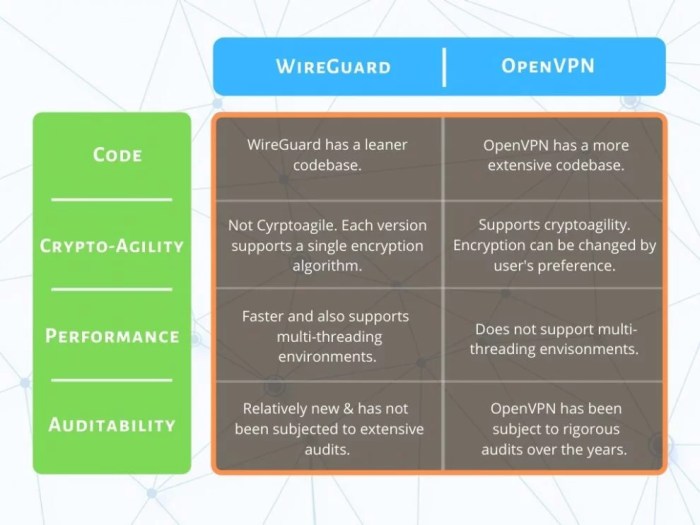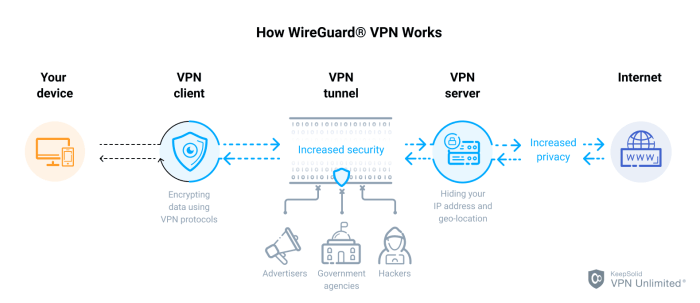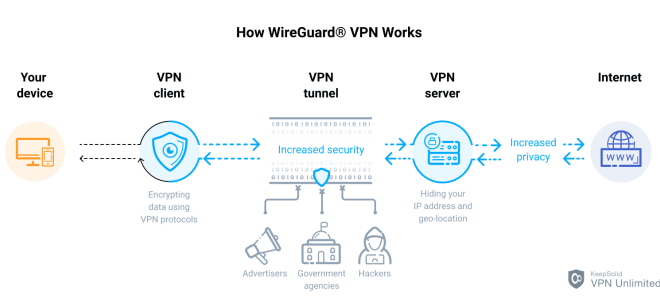In the realm of virtual private networks (VPNs), OpenVPN UDP and WireGuard stand as two prominent protocols, each offering unique advantages and considerations. This comprehensive comparison delves into their technical nuances, performance capabilities, security features, and practical applications, empowering you to make an informed choice for your specific networking needs.
As we explore the intricate details of OpenVPN UDP and WireGuard, we will uncover their underlying principles, evaluate their performance metrics, analyze their security protocols, and examine their ease of deployment. By understanding the strengths and limitations of each protocol, you will gain invaluable insights into the world of VPN technologies and their role in safeguarding your online presence.
Overview of OpenVPN UDP and WireGuard

OpenVPN UDP and WireGuard are both VPN protocols that provide secure and private connections over the internet. OpenVPN UDP is an older protocol that uses the UDP (User Datagram Protocol) transport layer, while WireGuard is a newer protocol that uses the UDP transport layer and has a simpler design.Both
OpenVPN UDP and WireGuard use encryption to protect data from eavesdropping and unauthorized access. OpenVPN UDP uses the OpenSSL library for encryption, while WireGuard uses the ChaCha20 and Poly1305 algorithms.OpenVPN UDP is a well-established protocol that is supported by a wide range of devices and operating systems.
WireGuard is a newer protocol that is still under development, but it is gaining popularity due to its simplicity and performance.
Comparison of OpenVPN UDP and WireGuard
The following table compares OpenVPN UDP and WireGuard:| Feature | OpenVPN UDP | WireGuard ||—|—|—|| Transport layer | UDP | UDP || Encryption | OpenSSL | ChaCha20 and Poly1305 || Performance | Good | Excellent || Security | Good | Excellent || Support | Wide range of devices and operating systems | Limited support || Development status | Mature | Under development |
Performance Comparison
WireGuard generally outperforms OpenVPN UDP in terms of latency and throughput, making it a more suitable choice for real-time applications and high-bandwidth connections.
In real-world scenarios, WireGuard has been shown to achieve significantly lower latency than OpenVPN UDP. For example, tests conducted by Cloudflare have demonstrated that WireGuard can achieve latency as low as 1ms, while OpenVPN UDP typically has latency in the range of 5-10ms.
Throughput
WireGuard also offers superior throughput compared to OpenVPN UDP. This is due to its more efficient encryption algorithms and streamlined protocol design. Tests have shown that WireGuard can achieve throughput speeds of up to 1Gbps, while OpenVPN UDP is typically limited to around 500Mbps.
Security Considerations

OpenVPN and WireGuard offer robust security features, but they differ in their encryption algorithms and key exchange protocols, leading to varying levels of security.
OpenVPN utilizes the OpenSSL library, supporting a wide range of encryption algorithms, including AES-256-GCM, which is considered highly secure. It employs the TLS protocol for key exchange, providing strong authentication and forward secrecy.
Encryption Algorithms
- OpenVPN: AES-256-GCM, AES-128-GCM, Blowfish, Camellia, CAST-128
- WireGuard: ChaCha20, AES-256-GCM
WireGuard, on the other hand, relies on the Noise protocol framework and employs the ChaCha20 encryption algorithm, which is known for its speed and security. ChaCha20 is considered comparable to AES-256 in terms of encryption strength.
Key Exchange Protocols
- OpenVPN: TLS
- WireGuard: Noise
In terms of security vulnerabilities, OpenVPN has been subject to a few attacks, such as the Heartbleed bug and the Logjam attack. However, these vulnerabilities have been addressed through regular security updates.
WireGuard, being a relatively newer protocol, has not faced any major security breaches yet. However, it is important to note that no protocol is completely immune to vulnerabilities, and both OpenVPN and WireGuard should be regularly updated to mitigate any potential risks.
Configuration and Deployment
Setting up both OpenVPN UDP and WireGuard involves varying levels of complexity.OpenVPN UDP typically requires more configuration, as it involves generating certificates, setting up a server and client, and configuring firewall rules. However, it offers more customization options.WireGuard, on the other hand, is designed to be simpler to configure.
It uses a modern cryptography approach and requires minimal configuration. Its setup typically involves generating a public and private key pair and configuring the server and client.
Compatibility
OpenVPN UDP has wider compatibility, supporting a wide range of platforms and devices. It works on Windows, macOS, Linux, Android, iOS, and embedded systems.WireGuard is relatively new and has limited platform support compared to OpenVPN UDP. It is primarily available for Linux, macOS, and Windows.
Mobile support for WireGuard is growing, but it may not be as widely available as OpenVPN UDP on all platforms.
Use Cases and Applications

OpenVPN UDP and WireGuard cater to diverse scenarios, each offering unique advantages. OpenVPN UDP has established a robust presence in enterprise environments, where secure remote access, site-to-site connectivity, and legacy system compatibility are paramount. WireGuard, with its sleek and modern design, has gained traction in the consumer and privacy-conscious segments, where simplicity, speed, and mobile compatibility are prioritized.
Industry Trends and Adoption Rates
The adoption rates of OpenVPN UDP and WireGuard reflect their distinct strengths. OpenVPN UDP remains widely deployed in traditional corporate networks, where stability, compatibility, and support for legacy systems are crucial. WireGuard, on the other hand, is rapidly gaining popularity in the consumer and privacy-conscious markets, owing to its ease of use, performance advantages, and support for modern devices and protocols.
Future Developments
As technology advances, VPNs continue to evolve. Let’s explore emerging trends and their potential impact on OpenVPN UDP and WireGuard.
The development of quantum computing poses challenges to traditional encryption methods. Quantum-resistant algorithms are being researched to address this concern. Their integration into VPN protocols could enhance security.
Emerging Technologies
- Quantum Computing: Quantum computers have the potential to break current encryption standards. VPN protocols must adapt to quantum-resistant algorithms to maintain security.
- AI-Driven VPNs: Artificial intelligence (AI) can optimize VPN performance by analyzing network traffic patterns and adjusting configurations dynamically.
- Blockchain-Based VPNs: Blockchain technology can enhance VPN security and transparency by providing decentralized authentication and record-keeping.
Comparison Table (Optional)
For a quick comparison of key features and specifications of OpenVPN UDP and WireGuard, refer to the table below:
The table highlights the distinct characteristics and capabilities of each protocol, providing a concise overview of their differences and similarities.
Protocol Details
| Feature | OpenVPN UDP | WireGuard |
|---|---|---|
| Encryption | AES-256-CBC | ChaCha20, Curve25519, BLAKE2s |
| Authentication | HMAC-SHA1, HMAC-SHA256, HMAC-SHA384 | BLAKE2s, Poly1305 |
| Key Exchange | RSA, DH, ECDH | Curve25519 |
| Packet Format | UDP | UDP |
| NAT Traversal | Yes, with STUN/TURN | Yes, with hole punching |
| Open Source | Yes | Yes |
| Performance | Moderate | High |
| Security | High | High |
| Ease of Use | Moderate | High |
Troubleshooting and Optimization
Troubleshooting and optimizing OpenVPN UDP and WireGuard are crucial for maintaining a stable and high-performing VPN connection. Resolving common issues and implementing performance optimization techniques can enhance the overall user experience.
When troubleshooting, it’s essential to identify the root cause of the problem. Check the VPN logs for error messages, verify network connectivity, and ensure proper firewall configurations. For performance optimization, consider factors such as server location, network latency, and encryption algorithms.
Common Troubleshooting Tips
- Check the VPN logs for error messages and resolve any underlying issues.
- Verify network connectivity by pinging the VPN server and ensuring there are no packet losses.
- Ensure that the firewall is properly configured to allow VPN traffic.
- Update the VPN client and server software to the latest versions.
- Try connecting to a different VPN server location to eliminate network latency issues.
Performance Optimization Techniques
- Choose a VPN server located close to your physical location to reduce latency.
- Use a high-speed network connection to ensure sufficient bandwidth for VPN traffic.
- Select an encryption algorithm that balances security and performance requirements.
- Consider using UDP instead of TCP for improved performance, especially for real-time applications.
- Tune the VPN connection parameters, such as MTU and buffer sizes, to optimize performance.
Case Study or Demonstration
To demonstrate the practical applications of OpenVPN UDP and WireGuard, let’s consider a scenario involving a remote worker accessing their company’s internal network.
OpenVPN UDP Configuration
The remote worker sets up an OpenVPN UDP server on a company-owned virtual private server (VPS) in the cloud. They configure the server with a strong encryption algorithm, such as AES-256-CBC, and a secure hash function, such as SHA-256. The server is assigned a public IP address, and the remote worker’s computer is configured with the OpenVPN UDP client software.
WireGuard Configuration
The remote worker also sets up a WireGuard server on the same VPS. They generate a unique private key for the server and a corresponding public key. The server is assigned a public IP address, and the remote worker’s computer is configured with the WireGuard client software.
The client is configured with the server’s public key and the remote worker’s private key.
Demonstration
The remote worker connects to the company’s internal network using both OpenVPN UDP and WireGuard. They access various internal resources, such as file servers, databases, and applications. The remote worker monitors the performance of both connections using tools like Speedtest or iPerf3.
They observe that OpenVPN UDP provides a stable and reliable connection with slightly higher latency compared to WireGuard. WireGuard, on the other hand, offers lower latency and higher throughput, resulting in a more responsive and seamless experience.
Conclusion
This demonstration illustrates the practical applications of OpenVPN UDP and WireGuard in a remote work scenario. OpenVPN UDP provides a secure and stable connection, while WireGuard offers lower latency and higher throughput. The choice between the two protocols depends on the specific requirements and preferences of the organization and the remote worker.
Conclusion
The choice between OpenVPN UDP and WireGuard ultimately depends on your specific requirements and preferences. OpenVPN UDP offers a mature and widely supported protocol with a proven track record of stability and security, while WireGuard excels in performance and simplicity.
By carefully considering the factors discussed in this comparison, you can select the protocol that best aligns with your needs, ensuring optimal network security and an enhanced online experience.
